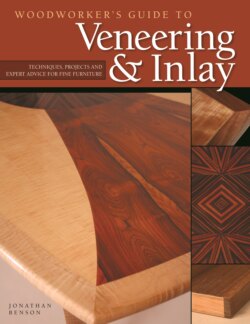Читать книгу Woodworker's Guide to Veneering & Inlay (SC) - Jonathan Benson - Страница 16
На сайте Литреса книга снята с продажи.
Flitch Cutting
ОглавлениеWhen sheets of veneer are sliced off the log (Figure 2-12) and kept together in sequential order, the resulting stack is known as a flitch (Figure 2-13). Veneer cut in this manner is referred to as flitch-cut veneer. Changing the orientation of the knife to the annual rings within the log creates a variety of grains and figures, which vary from species to species. Knowledge of wood characteristics is needed to best utilize each log. Veneer Slicing and Figure on pages 20-21 shows examples of common types of flitch cuts, and the resultant grain patterns and figures. To order veneer, the exact way the veneer is cut from the log is less important than knowing the types of grain and figure patterns available. Knowing the appearance of pattern and figure can create design possibilities and inspire new designs.
Figure in Veneer Species
Photos of veneers in my own inventory show examples of the color and figure available. Many of the species are not available as solid wood, and some, such as the pre-1992 vintage rosewood, are extremely rare. (Rosewood is protected; it is illegal to possess rosewood cut more recently than 1992). The samples have not been sanded or finished—what you see is the raw veneer. The examples are a fraction of the myriad of species and cuts available.
After proper orientation of the log and knife are established, the log is cut to shape and conditioned by being boiled or steamed in large vats of water or chemicals. The conditioning softens the wood fibers, allowing them to be sliced cleanly without tearing, ripping, or splitting. An additional run of the log through the metal detector helps operators find and remove nails or other items that might damage the valuable, vulnerable knife edge. Veneers cut with a nicked knife exhibit either a raised mark or a trough running diagonally across each sheet (Figure 2-14). Veneers cut with a dull knife will have grain torn out on every other sheet. Both defects can add a lot of sanding time, particularly with harder woods, and should be avoided.
Figure 2-12. A veneer-slicing machine moves the log against a heavy knife, which slices the veneer leaves. (Photo courtesy Erath Veneer Corporation.)
Figure 2-13. Flitch-cut veneers are carefully stacked in sequential order as they come off the slicing machine.
